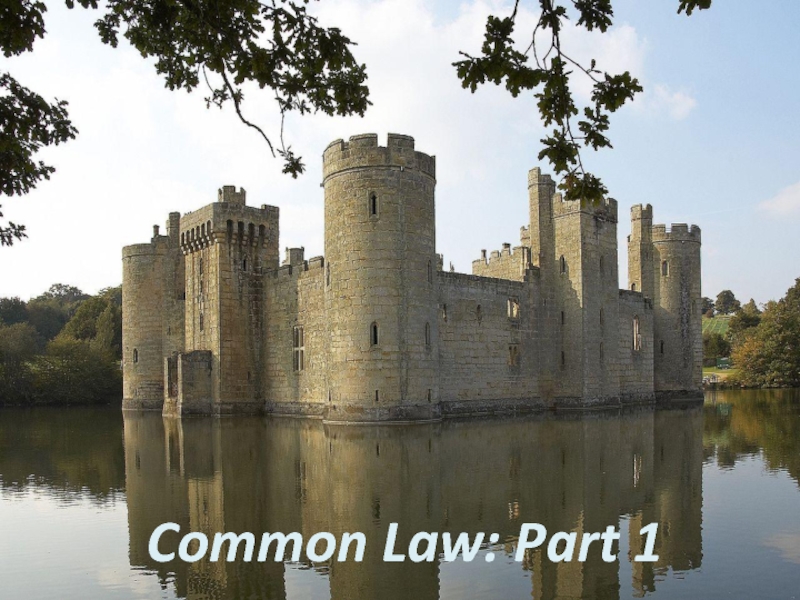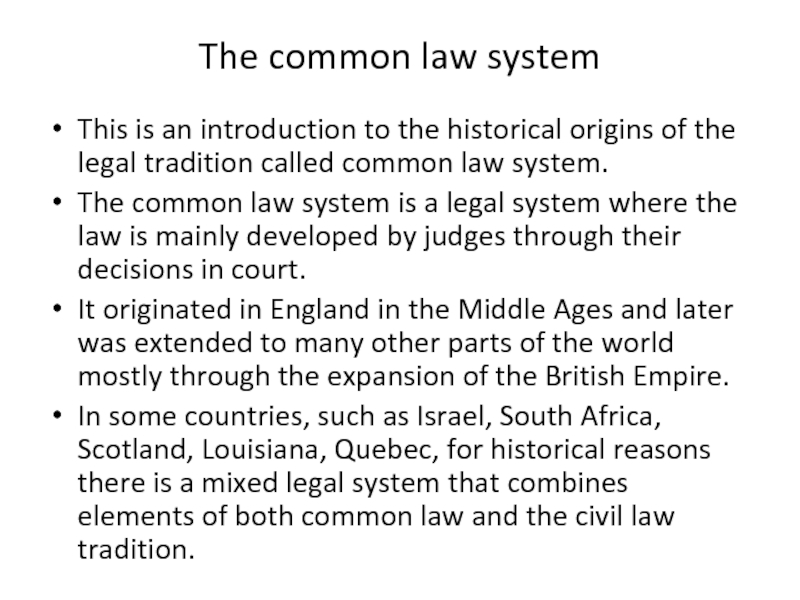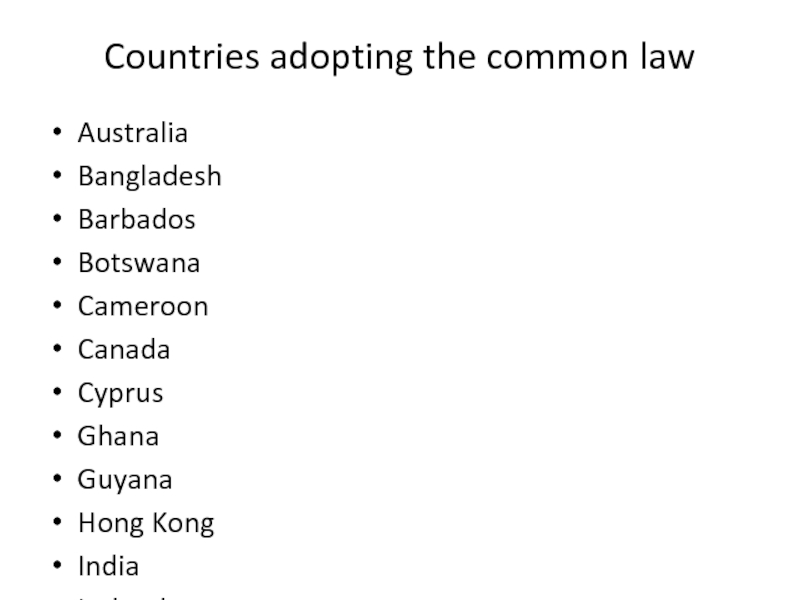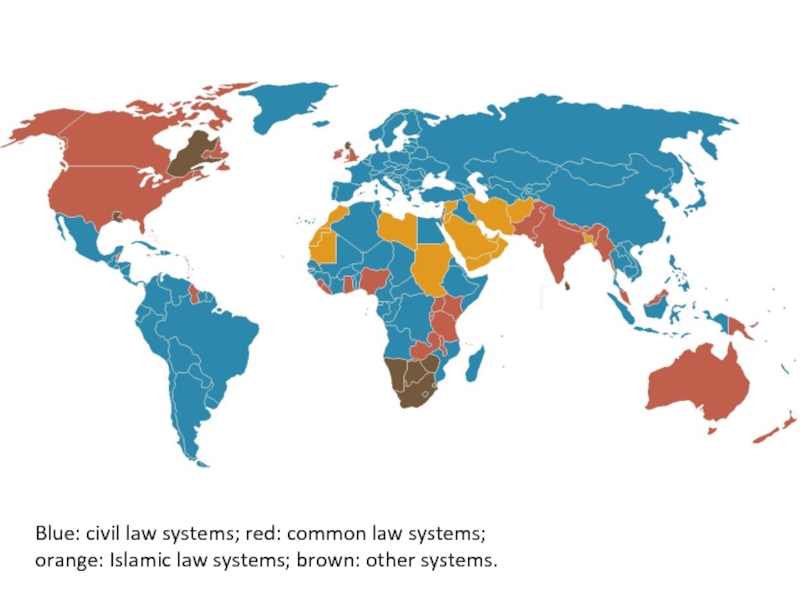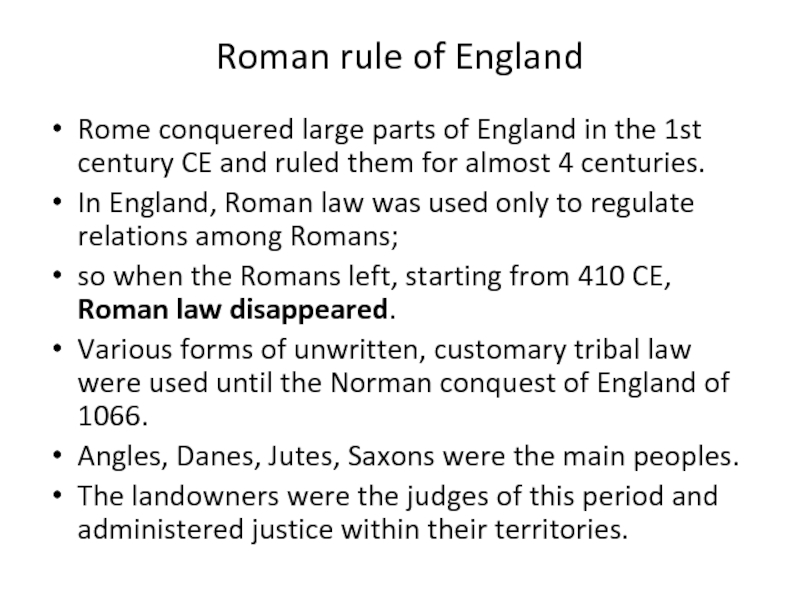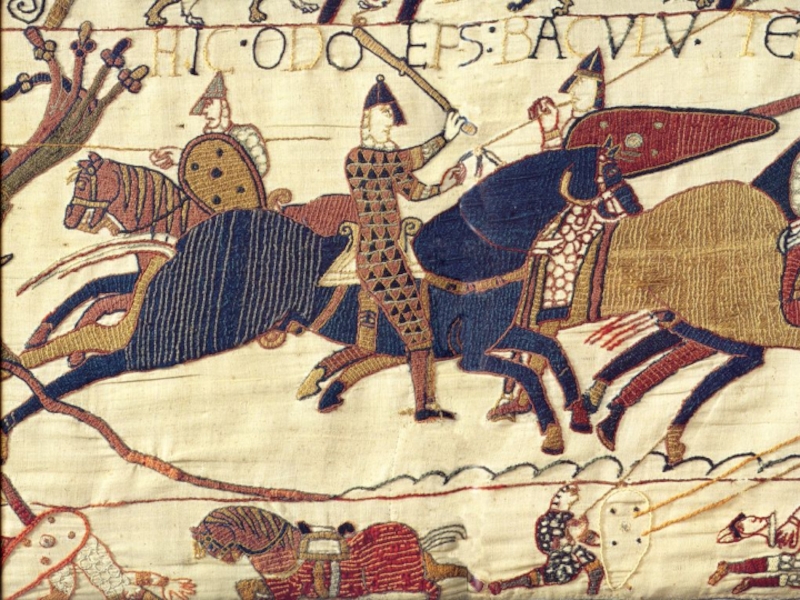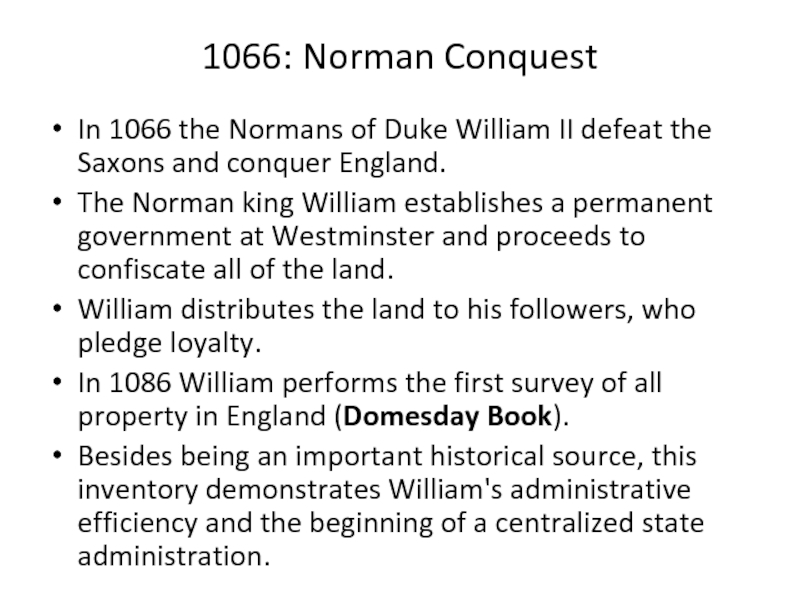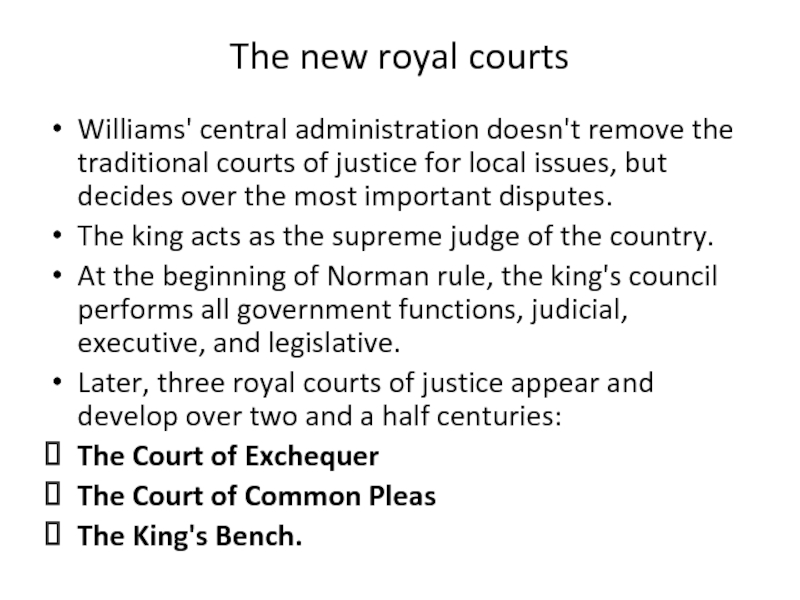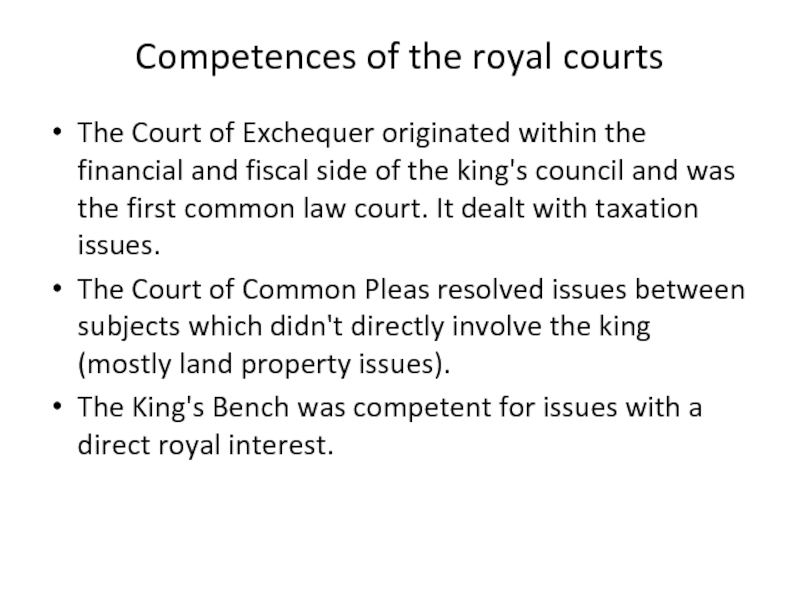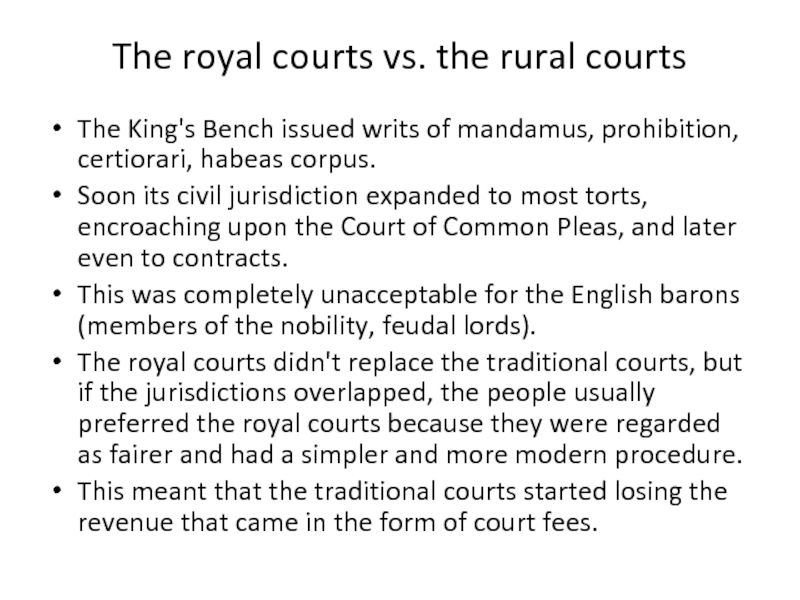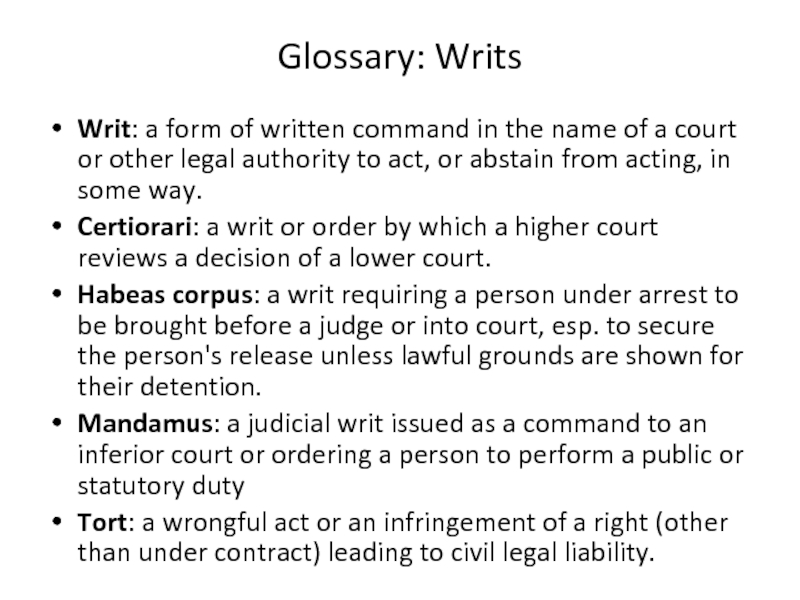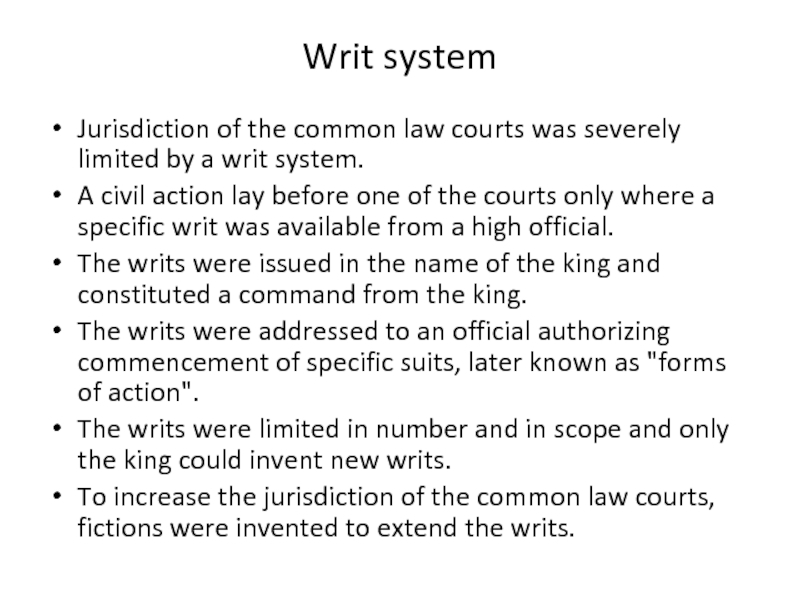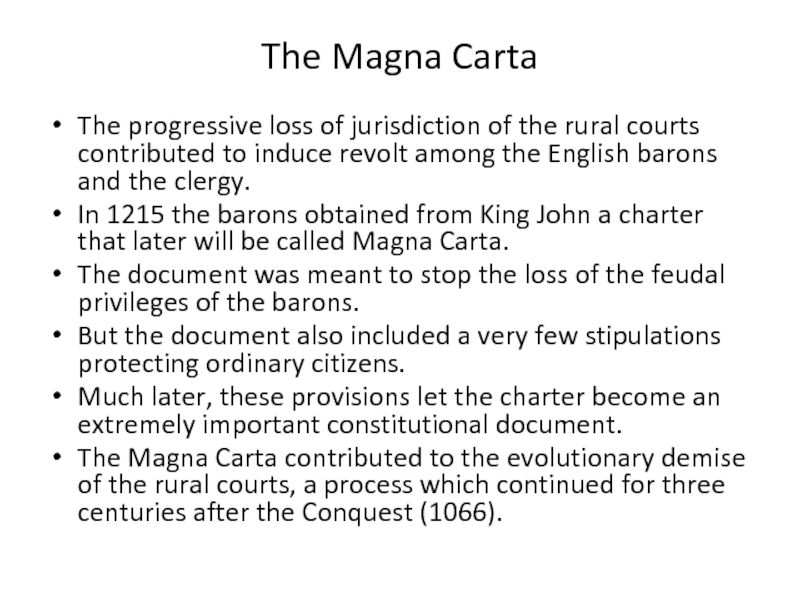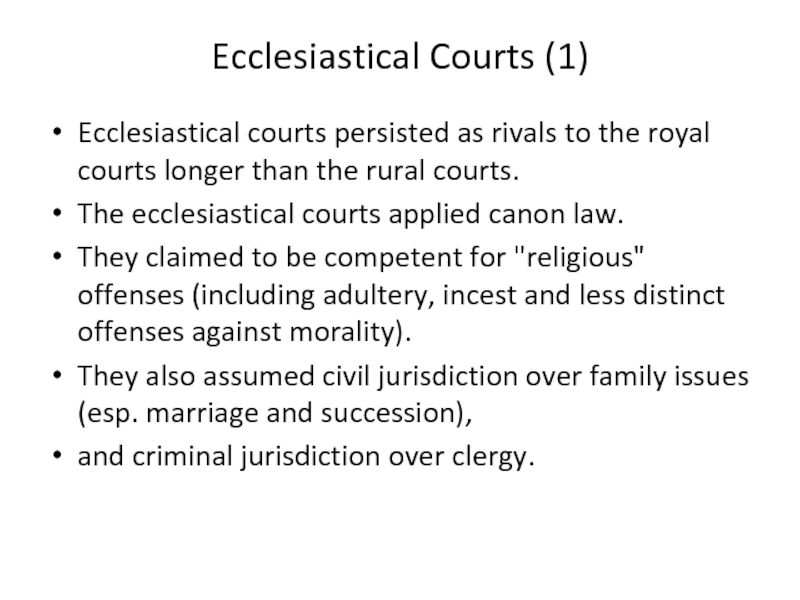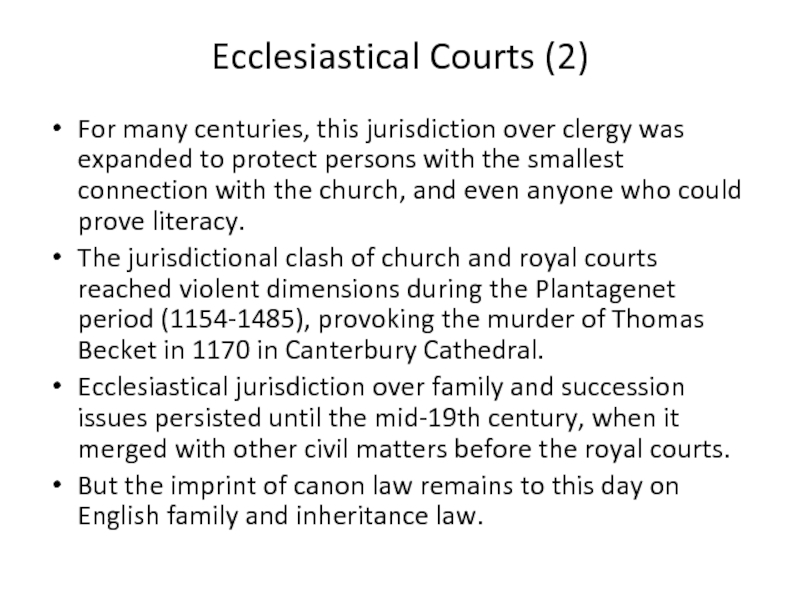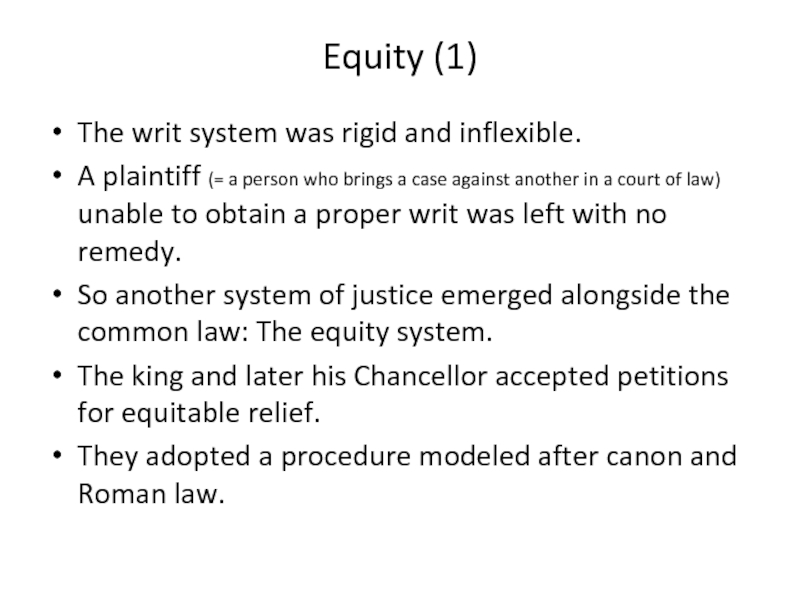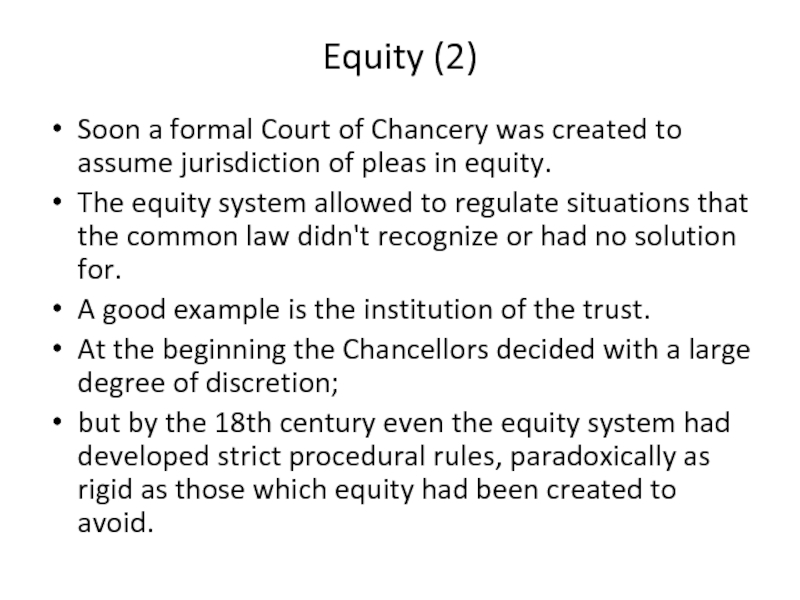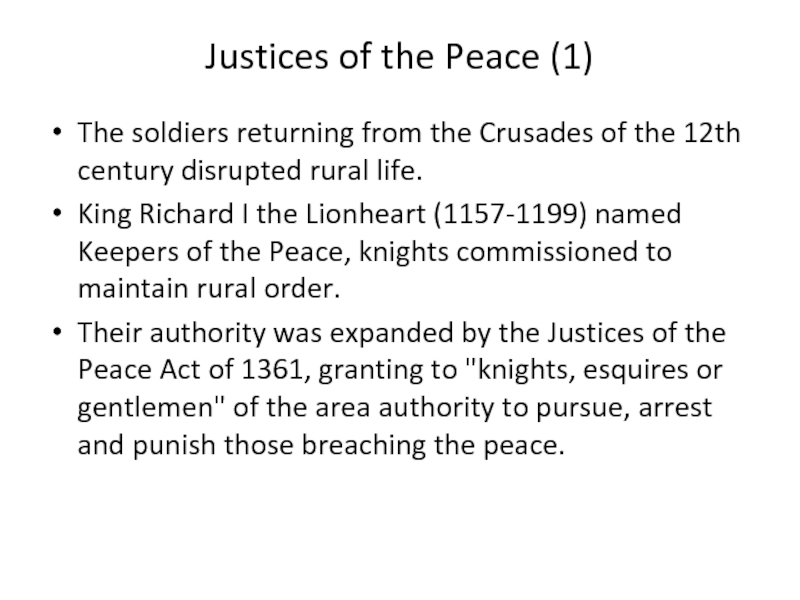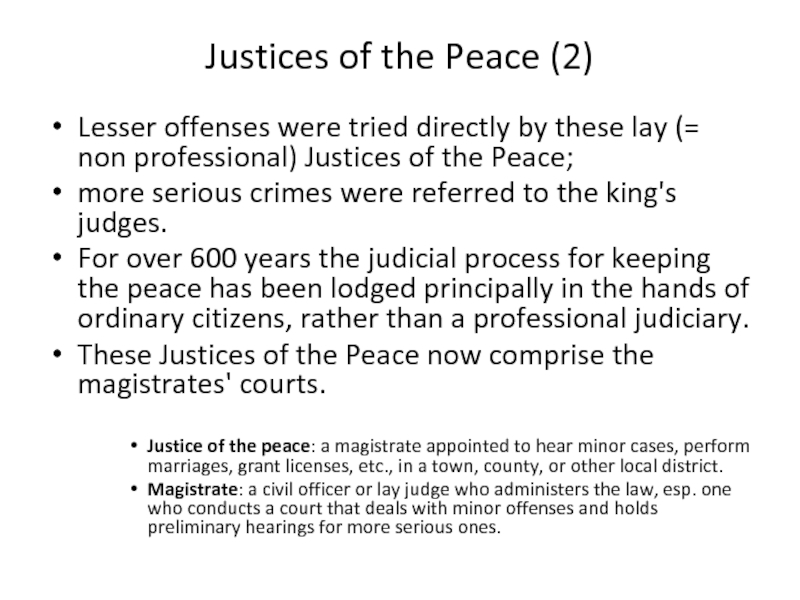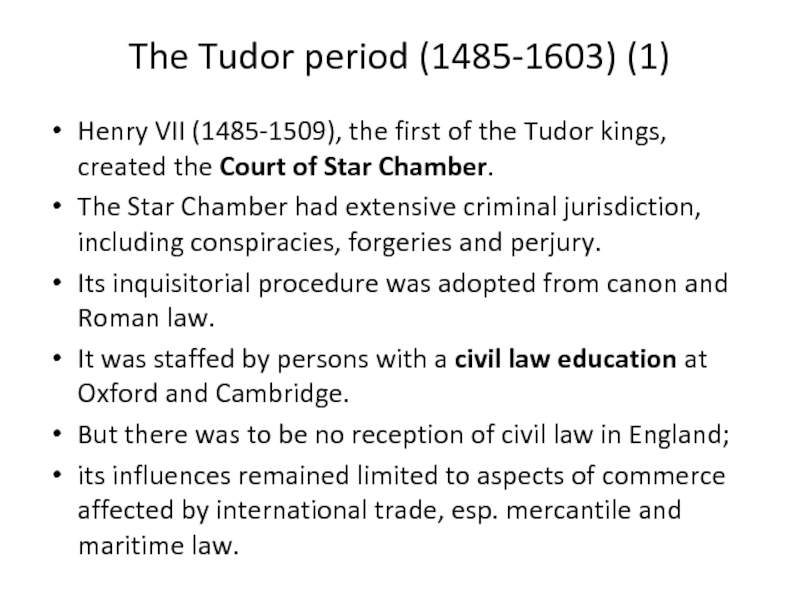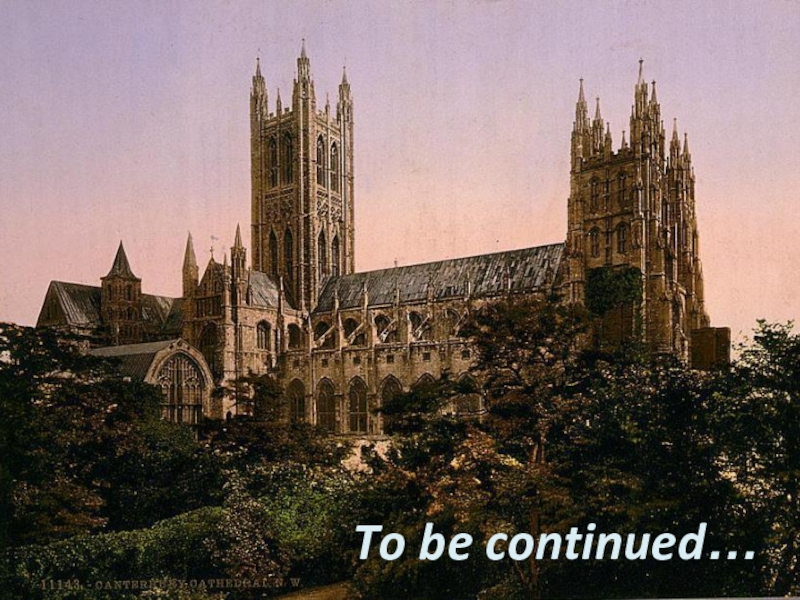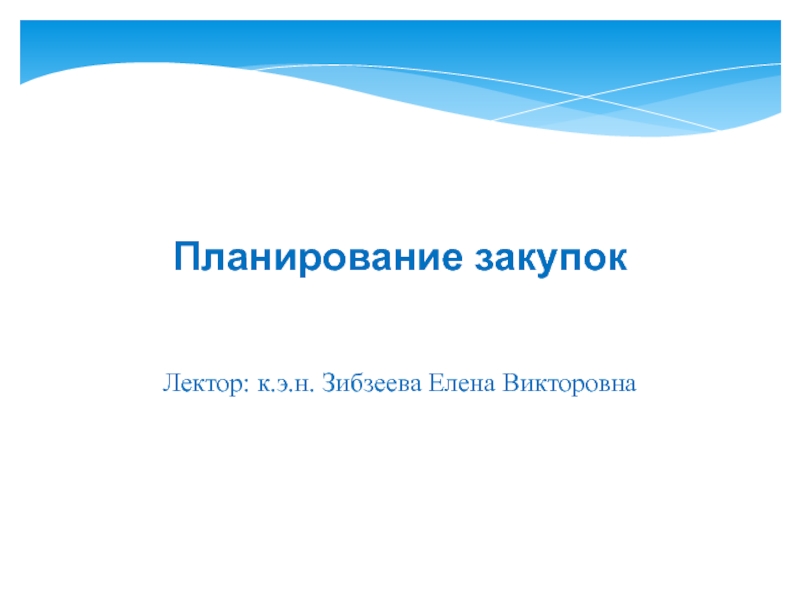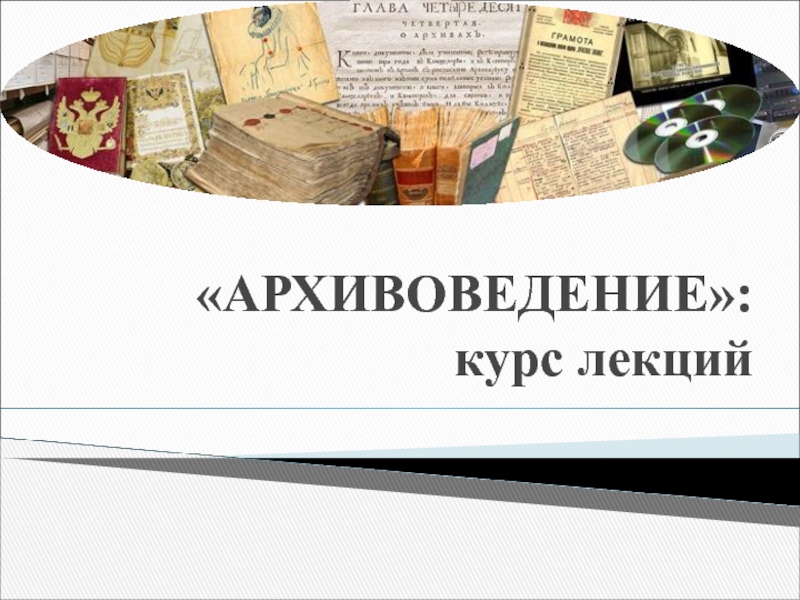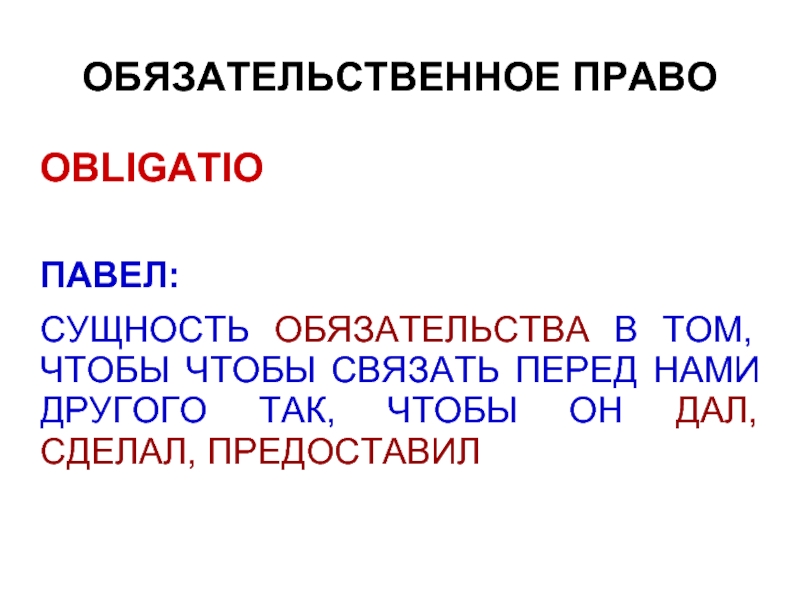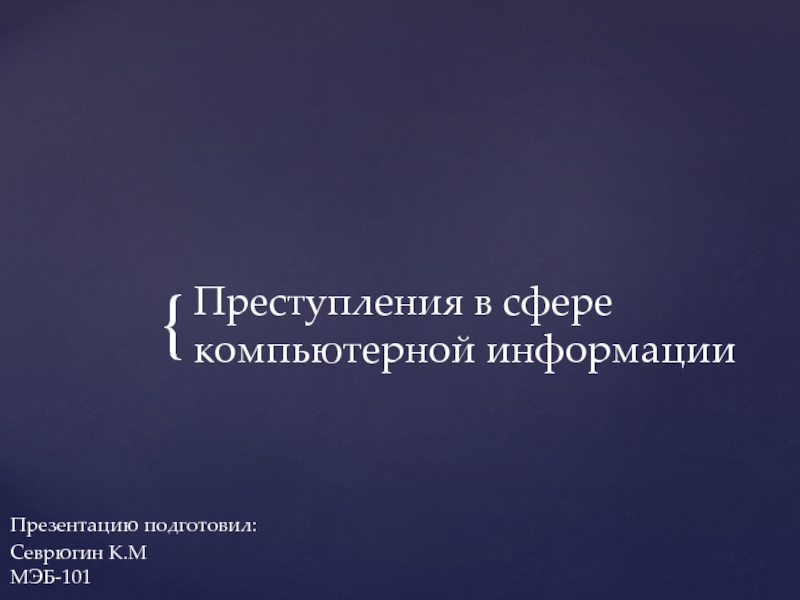- Главная
- Разное
- Дизайн
- Бизнес и предпринимательство
- Аналитика
- Образование
- Развлечения
- Красота и здоровье
- Финансы
- Государство
- Путешествия
- Спорт
- Недвижимость
- Армия
- Графика
- Культурология
- Еда и кулинария
- Лингвистика
- Английский язык
- Астрономия
- Алгебра
- Биология
- География
- Детские презентации
- Информатика
- История
- Литература
- Маркетинг
- Математика
- Медицина
- Менеджмент
- Музыка
- МХК
- Немецкий язык
- ОБЖ
- Обществознание
- Окружающий мир
- Педагогика
- Русский язык
- Технология
- Физика
- Философия
- Химия
- Шаблоны, картинки для презентаций
- Экология
- Экономика
- Юриспруденция
The common law system презентация
Содержание
- 1. The common law system
- 2. The common law system This is an
- 3. Countries adopting the common law Australia Bangladesh
- 4. Blue: civil law systems; red: common law
- 5. Roman rule of England Rome conquered large
- 7. 1066: Norman Conquest In 1066 the Normans
- 8. The new royal courts Williams' central administration
- 9. Competences of the royal courts The Court
- 10. The royal courts vs. the rural courts
- 11. Glossary: Writs Writ: a form of written
- 12. Writ system Jurisdiction of the common law
- 13. The Magna Carta The progressive loss of
- 14. Ecclesiastical Courts (1) Ecclesiastical courts persisted as
- 15. Ecclesiastical Courts (2) For many centuries, this
- 16. Equity (1) The writ system was rigid
- 17. Equity (2) Soon a formal Court of
- 18. Justices of the Peace (1) The soldiers
- 19. Justices of the Peace (2) Lesser offenses
- 20. The Tudor period (1485-1603) (1) Henry VII
- 21. The Tudor period (1485-1603) (2) In this
- 22. To be continued…
Слайд 2The common law system
This is an introduction to the historical origins
of the legal tradition called common law system.
The common law system is a legal system where the law is mainly developed by judges through their decisions in court.
It originated in England in the Middle Ages and later was extended to many other parts of the world mostly through the expansion of the British Empire.
In some countries, such as Israel, South Africa, Scotland, Louisiana, Quebec, for historical reasons there is a mixed legal system that combines elements of both common law and the civil law tradition.
The common law system is a legal system where the law is mainly developed by judges through their decisions in court.
It originated in England in the Middle Ages and later was extended to many other parts of the world mostly through the expansion of the British Empire.
In some countries, such as Israel, South Africa, Scotland, Louisiana, Quebec, for historical reasons there is a mixed legal system that combines elements of both common law and the civil law tradition.
Слайд 3Countries adopting the common law
Australia
Bangladesh
Barbados
Botswana
Cameroon
Canada
Cyprus
Ghana
Guyana
Hong Kong
India
Ireland
Israel
Jamaica
Malaysia
Namibia
New Zealand
Nigeria
Pakistan
Singapore
South Africa
Sri Lanka
Trinidad & Tobago
United
Kingdom (part)
United States
Zimbabwe
United States
Zimbabwe
Слайд 4Blue: civil law systems; red: common law systems;
orange: Islamic law
systems; brown: other systems.
Слайд 5Roman rule of England
Rome conquered large parts of England in the
1st century CE and ruled them for almost 4 centuries.
In England, Roman law was used only to regulate relations among Romans;
so when the Romans left, starting from 410 CE, Roman law disappeared.
Various forms of unwritten, customary tribal law were used until the Norman conquest of England of 1066.
Angles, Danes, Jutes, Saxons were the main peoples.
The landowners were the judges of this period and administered justice within their territories.
In England, Roman law was used only to regulate relations among Romans;
so when the Romans left, starting from 410 CE, Roman law disappeared.
Various forms of unwritten, customary tribal law were used until the Norman conquest of England of 1066.
Angles, Danes, Jutes, Saxons were the main peoples.
The landowners were the judges of this period and administered justice within their territories.
Слайд 71066: Norman Conquest
In 1066 the Normans of Duke William II defeat
the Saxons and conquer England.
The Norman king William establishes a permanent government at Westminster and proceeds to confiscate all of the land.
William distributes the land to his followers, who pledge loyalty.
In 1086 William performs the first survey of all property in England (Domesday Book).
Besides being an important historical source, this inventory demonstrates William's administrative efficiency and the beginning of a centralized state administration.
The Norman king William establishes a permanent government at Westminster and proceeds to confiscate all of the land.
William distributes the land to his followers, who pledge loyalty.
In 1086 William performs the first survey of all property in England (Domesday Book).
Besides being an important historical source, this inventory demonstrates William's administrative efficiency and the beginning of a centralized state administration.
Слайд 8The new royal courts
Williams' central administration doesn't remove the traditional courts
of justice for local issues, but decides over the most important disputes.
The king acts as the supreme judge of the country.
At the beginning of Norman rule, the king's council performs all government functions, judicial, executive, and legislative.
Later, three royal courts of justice appear and develop over two and a half centuries:
The Court of Exchequer
The Court of Common Pleas
The King's Bench.
The king acts as the supreme judge of the country.
At the beginning of Norman rule, the king's council performs all government functions, judicial, executive, and legislative.
Later, three royal courts of justice appear and develop over two and a half centuries:
The Court of Exchequer
The Court of Common Pleas
The King's Bench.
Слайд 9Competences of the royal courts
The Court of Exchequer originated within the
financial and fiscal side of the king's council and was the first common law court. It dealt with taxation issues.
The Court of Common Pleas resolved issues between subjects which didn't directly involve the king (mostly land property issues).
The King's Bench was competent for issues with a direct royal interest.
The Court of Common Pleas resolved issues between subjects which didn't directly involve the king (mostly land property issues).
The King's Bench was competent for issues with a direct royal interest.
Слайд 10The royal courts vs. the rural courts
The King's Bench issued writs
of mandamus, prohibition, certiorari, habeas corpus.
Soon its civil jurisdiction expanded to most torts, encroaching upon the Court of Common Pleas, and later even to contracts.
This was completely unacceptable for the English barons (members of the nobility, feudal lords).
The royal courts didn't replace the traditional courts, but if the jurisdictions overlapped, the people usually preferred the royal courts because they were regarded as fairer and had a simpler and more modern procedure.
This meant that the traditional courts started losing the revenue that came in the form of court fees.
Soon its civil jurisdiction expanded to most torts, encroaching upon the Court of Common Pleas, and later even to contracts.
This was completely unacceptable for the English barons (members of the nobility, feudal lords).
The royal courts didn't replace the traditional courts, but if the jurisdictions overlapped, the people usually preferred the royal courts because they were regarded as fairer and had a simpler and more modern procedure.
This meant that the traditional courts started losing the revenue that came in the form of court fees.
Слайд 11Glossary: Writs
Writ: a form of written command in the name of
a court or other legal authority to act, or abstain from acting, in some way.
Certiorari: a writ or order by which a higher court reviews a decision of a lower court.
Habeas corpus: a writ requiring a person under arrest to be brought before a judge or into court, esp. to secure the person's release unless lawful grounds are shown for their detention.
Mandamus: a judicial writ issued as a command to an inferior court or ordering a person to perform a public or statutory duty
Tort: a wrongful act or an infringement of a right (other than under contract) leading to civil legal liability.
Certiorari: a writ or order by which a higher court reviews a decision of a lower court.
Habeas corpus: a writ requiring a person under arrest to be brought before a judge or into court, esp. to secure the person's release unless lawful grounds are shown for their detention.
Mandamus: a judicial writ issued as a command to an inferior court or ordering a person to perform a public or statutory duty
Tort: a wrongful act or an infringement of a right (other than under contract) leading to civil legal liability.
Слайд 12Writ system
Jurisdiction of the common law courts was severely limited by
a writ system.
A civil action lay before one of the courts only where a specific writ was available from a high official.
The writs were issued in the name of the king and constituted a command from the king.
The writs were addressed to an official authorizing commencement of specific suits, later known as "forms of action".
The writs were limited in number and in scope and only the king could invent new writs.
To increase the jurisdiction of the common law courts, fictions were invented to extend the writs.
A civil action lay before one of the courts only where a specific writ was available from a high official.
The writs were issued in the name of the king and constituted a command from the king.
The writs were addressed to an official authorizing commencement of specific suits, later known as "forms of action".
The writs were limited in number and in scope and only the king could invent new writs.
To increase the jurisdiction of the common law courts, fictions were invented to extend the writs.
Слайд 13The Magna Carta
The progressive loss of jurisdiction of the rural courts
contributed to induce revolt among the English barons and the clergy.
In 1215 the barons obtained from King John a charter that later will be called Magna Carta.
The document was meant to stop the loss of the feudal privileges of the barons.
But the document also included a very few stipulations protecting ordinary citizens.
Much later, these provisions let the charter become an extremely important constitutional document.
The Magna Carta contributed to the evolutionary demise of the rural courts, a process which continued for three centuries after the Conquest (1066).
In 1215 the barons obtained from King John a charter that later will be called Magna Carta.
The document was meant to stop the loss of the feudal privileges of the barons.
But the document also included a very few stipulations protecting ordinary citizens.
Much later, these provisions let the charter become an extremely important constitutional document.
The Magna Carta contributed to the evolutionary demise of the rural courts, a process which continued for three centuries after the Conquest (1066).
Слайд 14Ecclesiastical Courts (1)
Ecclesiastical courts persisted as rivals to the royal courts
longer than the rural courts.
The ecclesiastical courts applied canon law.
They claimed to be competent for "religious" offenses (including adultery, incest and less distinct offenses against morality).
They also assumed civil jurisdiction over family issues (esp. marriage and succession),
and criminal jurisdiction over clergy.
The ecclesiastical courts applied canon law.
They claimed to be competent for "religious" offenses (including adultery, incest and less distinct offenses against morality).
They also assumed civil jurisdiction over family issues (esp. marriage and succession),
and criminal jurisdiction over clergy.
Слайд 15Ecclesiastical Courts (2)
For many centuries, this jurisdiction over clergy was expanded
to protect persons with the smallest connection with the church, and even anyone who could prove literacy.
The jurisdictional clash of church and royal courts reached violent dimensions during the Plantagenet period (1154-1485), provoking the murder of Thomas Becket in 1170 in Canterbury Cathedral.
Ecclesiastical jurisdiction over family and succession issues persisted until the mid-19th century, when it merged with other civil matters before the royal courts.
But the imprint of canon law remains to this day on English family and inheritance law.
The jurisdictional clash of church and royal courts reached violent dimensions during the Plantagenet period (1154-1485), provoking the murder of Thomas Becket in 1170 in Canterbury Cathedral.
Ecclesiastical jurisdiction over family and succession issues persisted until the mid-19th century, when it merged with other civil matters before the royal courts.
But the imprint of canon law remains to this day on English family and inheritance law.
Слайд 16Equity (1)
The writ system was rigid and inflexible.
A plaintiff (=
a person who brings a case against another in a court of law) unable to obtain a proper writ was left with no remedy.
So another system of justice emerged alongside the common law: The equity system.
The king and later his Chancellor accepted petitions for equitable relief.
They adopted a procedure modeled after canon and Roman law.
So another system of justice emerged alongside the common law: The equity system.
The king and later his Chancellor accepted petitions for equitable relief.
They adopted a procedure modeled after canon and Roman law.
Слайд 17Equity (2)
Soon a formal Court of Chancery was created to assume
jurisdiction of pleas in equity.
The equity system allowed to regulate situations that the common law didn't recognize or had no solution for.
A good example is the institution of the trust.
At the beginning the Chancellors decided with a large degree of discretion;
but by the 18th century even the equity system had developed strict procedural rules, paradoxically as rigid as those which equity had been created to avoid.
The equity system allowed to regulate situations that the common law didn't recognize or had no solution for.
A good example is the institution of the trust.
At the beginning the Chancellors decided with a large degree of discretion;
but by the 18th century even the equity system had developed strict procedural rules, paradoxically as rigid as those which equity had been created to avoid.
Слайд 18Justices of the Peace (1)
The soldiers returning from the Crusades of
the 12th century disrupted rural life.
King Richard I the Lionheart (1157-1199) named Keepers of the Peace, knights commissioned to maintain rural order.
Their authority was expanded by the Justices of the Peace Act of 1361, granting to "knights, esquires or gentlemen" of the area authority to pursue, arrest and punish those breaching the peace.
King Richard I the Lionheart (1157-1199) named Keepers of the Peace, knights commissioned to maintain rural order.
Their authority was expanded by the Justices of the Peace Act of 1361, granting to "knights, esquires or gentlemen" of the area authority to pursue, arrest and punish those breaching the peace.
Слайд 19Justices of the Peace (2)
Lesser offenses were tried directly by these
lay (= non professional) Justices of the Peace;
more serious crimes were referred to the king's judges.
For over 600 years the judicial process for keeping the peace has been lodged principally in the hands of ordinary citizens, rather than a professional judiciary.
These Justices of the Peace now comprise the magistrates' courts.
Justice of the peace: a magistrate appointed to hear minor cases, perform marriages, grant licenses, etc., in a town, county, or other local district.
Magistrate: a civil officer or lay judge who administers the law, esp. one who conducts a court that deals with minor offenses and holds preliminary hearings for more serious ones.
more serious crimes were referred to the king's judges.
For over 600 years the judicial process for keeping the peace has been lodged principally in the hands of ordinary citizens, rather than a professional judiciary.
These Justices of the Peace now comprise the magistrates' courts.
Justice of the peace: a magistrate appointed to hear minor cases, perform marriages, grant licenses, etc., in a town, county, or other local district.
Magistrate: a civil officer or lay judge who administers the law, esp. one who conducts a court that deals with minor offenses and holds preliminary hearings for more serious ones.
Слайд 20The Tudor period (1485-1603) (1)
Henry VII (1485-1509), the first of the
Tudor kings, created the Court of Star Chamber.
The Star Chamber had extensive criminal jurisdiction, including conspiracies, forgeries and perjury.
Its inquisitorial procedure was adopted from canon and Roman law.
It was staffed by persons with a civil law education at Oxford and Cambridge.
But there was to be no reception of civil law in England;
its influences remained limited to aspects of commerce affected by international trade, esp. mercantile and maritime law.
The Star Chamber had extensive criminal jurisdiction, including conspiracies, forgeries and perjury.
Its inquisitorial procedure was adopted from canon and Roman law.
It was staffed by persons with a civil law education at Oxford and Cambridge.
But there was to be no reception of civil law in England;
its influences remained limited to aspects of commerce affected by international trade, esp. mercantile and maritime law.
Слайд 21The Tudor period (1485-1603) (2)
In this period, the Parliament is established
as a legislative chamber separate from the monarch and his council, although still closely controlled by the monarch.
The strengthening of the Parliament was backed by the proponents of the common law, who feared the gathering power being exercised by the monarch.
A populace benefiting from an improving quality of life and concerned with the unsettling consequences of the abuse of royal power, began to limit the use of the royal prerogative.
By the end of the Tudor period the Parliament achieved status as the supreme law-making body:
Only the Parliament's laws, not sovereign decrees, were binding on the courts.
The strengthening of the Parliament was backed by the proponents of the common law, who feared the gathering power being exercised by the monarch.
A populace benefiting from an improving quality of life and concerned with the unsettling consequences of the abuse of royal power, began to limit the use of the royal prerogative.
By the end of the Tudor period the Parliament achieved status as the supreme law-making body:
Only the Parliament's laws, not sovereign decrees, were binding on the courts.
